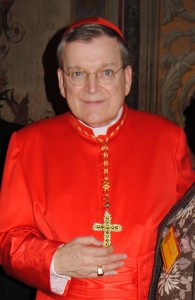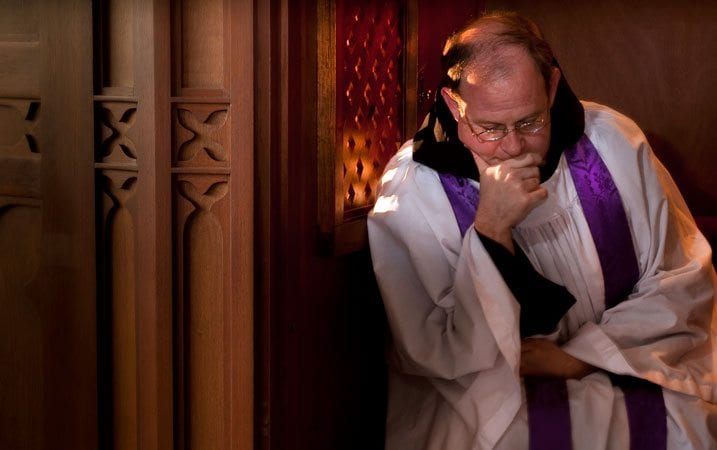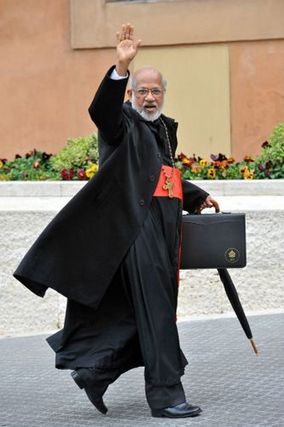 On November 8, the Holy Father Francis received in audience participants in the Plenary Assembly of the Supreme Tribunal of the Apostolic Signature with the Prefect, Raymond Leo Cardinal Burke (he’s one of our American Prelates in service to the Holy Father at the Curia). A plenary session allows for the consulters and those assigned to a particular office to meet to discuss business but also to meet with the Pope so as to hear what he has to say on a particular theme of his choosing. A plenary session is held once a year.
On November 8, the Holy Father Francis received in audience participants in the Plenary Assembly of the Supreme Tribunal of the Apostolic Signature with the Prefect, Raymond Leo Cardinal Burke (he’s one of our American Prelates in service to the Holy Father at the Curia). A plenary session allows for the consulters and those assigned to a particular office to meet to discuss business but also to meet with the Pope so as to hear what he has to say on a particular theme of his choosing. A plenary session is held once a year.
The Wisconsin native, Raymond Leo Cardinal Burke is a brilliant noteworthy churchman. His Eminence earned his doctorate in Canon Law from the Gregorian University in 1984. John Paul named Burke to be the Defender of the Bond of the same tribunal he now leads. He was previously the bishop of La Crosse and archbishop of St Louis. Pope Benedict appointed him to the present work in 2008 and a cardinal in 2010.
Supreme Tribunal of the Apostolic Signature, one of three ecclesiastical tribunals of the Holy See, is the highest judicial authority of the Church; the Prefect, acting in the name of the Pope, is the minister of justice. The decree of justice is sent under a signature, hence, “signature,” administering the justice asked for by the people of God. There are 25 prelates who assist the Prefect and his staff. You can learn more about the ministry of the Apostolic Signature by reading the articles in Pastor Bonus.
Here, the Pope focuses on truth and justice in the work of the Defender of the Bond with regard to the sacrament of Marriage. The Defender of the Bond and the judge of martial cases work together to ascertain the truth and are not in competition with each other but is the point of communion between what is revealed in scripture, lived in the sacraments and lived in the world. You can see to what extent Mother Church tries to care for her married children in a time of hurt and discouragement.
The following his Francis’ talk with my emphasis.
This, your Plenary Session, gives me the opportunity to receive all of you who work in the Supreme Tribunal of the Apostolic Signature, expressing to each one my gratitude for the promotion of the correct administration of justice in the Church. I greet you cordially and I thank the Cardinal Prefect for the words with which he introduced our meeting.
Your activity is geared to fostering the work of the ecclesiastical tribunals, called to respond adequately to the faithful who turn to the justice of the Church to obtain a correct decision. You do your utmost so that they function well, and you support the responsibility of bishops in forming suitable ministers of justice. Among these, the Defender of the Bond carries out an important function, especially in the process of matrimonial nullity. It is necessary, in fact, that he be able to fulfill his own part with efficacy, to facilitate the attainment of truth in the definitive sentence, in favor of the pastoral good of the parties in question.
In this regard, the Apostolic Signature has offered significant contributions. I am thinking in particular of the collaboration in the preparation of the Instruction Dignitas connubii, which explains the applicable trial norms. Placed in this line also is the present Plenary Session, which has put at the center of its works the promotion of an effective defense of the matrimonial bond in the canonical processes of nullity.
The attention given to the ministry of the Defender of the Bond is without a doubt opportune, because his presence and his intervention are obligatory for the whole development of the process (cf. Dignitas connubii, 56, 1-2; 279, 1). Foreseen in the same way is that he must propose all sorts of proofs, exceptions, recourses and appeals that, in respect of the truth, foster the defense of the bond.
The mentioned Instruction describes, in particular, the role of the Defender of the Bond in the causes of nullity for psychic incapacity, which in some Tribunals constitute the sole reason for nullity. It underlines the diligence that he must put in assessing the questions addressed to the experts, as well as the results of the opinions themselves (cf. 56, 4). Therefore, the Defender of the Bond who wishes to render a good service cannot limit himself to a hasty reading of the acts, or to bureaucratic and generic answers. In his delicate task, he is called to try to harmonize the prescriptions of the Code of Canon Law with the concrete situations of the Church and of society.
The faithful and complete fulfillment of the task of the Defender of the Bond does not constitute a pretension damaging of the prerogatives of the ecclesiastical judge, to whom corresponds solely the definition of the cause. When the Defender of the Bond exercises the duty to appeal, also to the Roman Rota, against a decision which he holds damaging to the truth of the bond, his task does not abuse that of the judge. In fact, the judges can find, in the careful work of him who defends the matrimonial bond, a help to their own activity.
The Second Ecumenical Vatican Council defined the Church as communion. Seen in this perspective are the service of the Defender of the Bond and the consideration that is reserved to him, in a respectful and attentive dialogue.
A final, very important annotation as regards the workers committed in the ministry of ecclesial justice. They act in the name of the Church; they are part of the Church. Therefore, it is necessary to always keep alive the connection between the action of the Church that evangelizes and the action of the Church that administers justice. The service to justice is a commitment of apostolic life: it requires to be exercised by keeping one’s gaze fixed on the icon of the Good Shepherd, who bends down to the lost and wounded sheep.
At the conclusion of this meeting, I encourage you all to persevere in the search for a limpid and correct exercise of justice in the Church, in response to the legitimate desires that the faithful address to Pastors, especially when, confidently, they ask to have their own status authoritatively clarified. May Mary Most Holy, who we invoke with the title Speculum iustitiae, help you and the whole Church to walk on the path of justice, which is the first form of charity. Thank you and good work!






